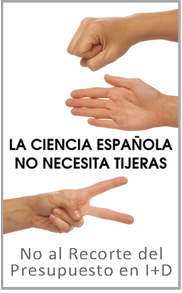Archive for marzo 2009
Cómo Escribir un Artículo Científico (Humor)
No me preguntéis qué link llevo a otro link que… dando una vueltecilla por internet, me he tropezado con Eric Schulman’s Science Humor Webpage, la página web de un señor que por lo visto se ha dedicado a lo grande a escribir de ciencia, pero en plan cachondeo.
Hoy os cuelgo «How to Write a Scientific Paper«, que no tiene desperdicio
1. Introduction
Scientific papers (e.g., Schulman 1988; Schulman & Fomalont 1992; Schulman, Bregman, & Roberts 1994; Schulman & Bregman 1995; Schulman 1996) are an important–though poorly understood–method of publication. They are important because without them scientists cannot get money from the government or from universities. They are poorly understood because they are not written very well (see, for example, Schulman 1995 and selected references therein). An excellent example of the latter phenomenon occurs in most introductions, which are supposed to introduce the reader to the subject so that the paper will be comprehensible even if the reader has not done any work in the field.
The real purpose of introductions, of course, is to cite your own work (e.g., Schulman et al. 1993a), the work of your advisor (e.g., Bregman, Schulman, & Tomisaka 1995), the work of your spouse (e.g., Cox, Schulman, & Bregman 1993), the work of a friend from college (e.g., Taylor, Morris, & Schulman 1993), or even the work of someone you’ve never met, as long as your name happens to be on the paper (e.g., Richmond et al. 1994). Note that these citations should not be limited to refereed journal articles (e.g., Collura et al. 1994), but should also include conference proceedings (e.g., Schulman et al. 1993b), and other published or unpublished work (e.g., Schulman 1990).
At the end of the introduction you must summarize the paper by reciting the section headings. In this paper, we discuss scientific research (section 2), scientific writing (section 3), scientific publication (section 4), and draw some conclusions (section 5).
2. Scientific Research
The purpose of science is to get paid for doing fun stuff (Schulman et al. 1991). Nominally, science involves discovering something new about the Universe, but this isn’t really necessary. What is really necessary is a grant. In order to obtain a grant, your application must state that the research will discover something incredibly fundamental. The grant agency must also believe that you are the best person to do this particular research, so you should cite yourself both early (Schulman 1994) and often (Schulman et al. 1993c). Feel free to cite other papers as well (e.g., Blakeslee et al. 1993; Levine et al. 1993), so long as you are on the author list.
Once you get the grant, your university, company, or government agency will immediately take 30 to 70% of it so that they can heat the building, pay for Internet connections, and purchase large yachts.
Now it’s time for the actual research. You will quickly find out that (a) your project is not as simple as you thought it would be and (b) you can’t actually solve the problem. However — and this is very important — you must publish anyway (Schulman & Bregman 1994).
3. Scientific Writing
You’ve spent years on a project and have finally discovered that you can’t solve the problem you set out to solve. Nonetheless, you have a responsibility to present your research to the scientific community (Schulman et al. 1993d). Be aware that negative results can be just as important as positive results, and also that if you don’t publish enough you’ll never be able to stay in science.
While writing a scientific paper, the most important thing to remember is that the word «which» should almost never be used. Be sure to spend at least 50% of your time (i.e., 12 hours a day) typesetting the paper so that all the tables look nice (Schulman & Bregman 1992).
4. Scientific Publishing
You’ve written the paper, and now it’s time to submit it to a scientific journal. The journal editor will pick the referee most likely to be offended by your paper, because then at least the referee will read it and get a report back within the lifetime of the editor. Referees who don’t care one way or the other about a paper have a tendency to leave manuscripts under a growing pile of paper until the floor collapses, killing the 27 English graduate students who share the office below (Schulman, Cox, & Williams 1993).
Be aware that every scientific paper contains serious errors. If your errors are not caught before publication, you’ll eventually have to write an erratum to the paper explaining (a) how and why you messed up and (b) that even though your experimental results are now totally different, your conclusions need not be changed. Errata can be good for your career. They are easy to write, and the convention is to reference them as if they were real papers, leading the casual reader–and perhaps also the Science Citation Index–to think that you’ve published more papers than you really have (Schulman et al. 1994).
5. Conclusions
The conclusion section is very easy to write: all you have to do is to take your abstract and change the tense from present to past. It’s considered good form to mention at least one relevant theory only in the abstract and conclusion. By doing this, you don’t have to say why your experiment does (or does not) agree with the theory, you merely have to state that it does (or does not).
We (meaning I) presented observations on the scientific publishing process which (meaning that) are important and timely in that unless I have more published papers soon, I will never get another job. These observations are consistent with the theory that it is difficult to do good science, write good scientific papers, and have enough publications to get future jobs.
Me hubiera gustado tener a mano el artículo científico de Caperucita Roja, pero mira que lo he buscado estos días y me temo que lo he perdido…
Entre la Ciencia y el Arte (2)
Seguimos con la sección Entre Ciencia y Arte con otro confocal:

La magia de la foto fué pillar «in fraganti» a una célula en plena división, distribuyendo su material genético en dos partes iguales, antes de romperse por la mitad…
Comics y Ciencia
Para los más parroquianos ver en sonicando viñetas sobre ciencia es algo muy normal (para el resto mirar un pelin más abajo, la anterior entrada). Durante el tiempo he ido recopilando una serie de páginas que me ayudan a meter un poco de humor por aquí, y hoy cuelgo un artículo sobre dichas páginas en El Museo De La Ciencia.
Si os interesa, no dudéis en daros una vuelta por el artículo del Museo, y si ya os quedáis un ratito a visitarlo, veréis que merece muy mucho la pena pasarse a ver que se cuece por allí…
¡Protege su Vida!
No hay nada como copiar una campaña de manipulación barata y darle unas vueltas. Aquí una captura de El Intermedio del Miércoles, que se merecía una entrada por todo lo alto.

A la derecha una Célula Madre protegida por la iglesia. A la izquierda un bebé africano, una especie en vía de extinción por la epidemia de Sida.
Porque una persona es más importante que una célula: ¡ Preservativos para Africa ya !
Pre..Preservativi
Seguimos con la saga de barbaridades salidas de la boca del líder santa madre iglesia. Titubeante el papa se refería ayer a pre-preservativi (primera vez que dice dicha palabra en público) para decir que el uso del mismo “no hace otra cosa que aumentar los problemas contra el Sida”. Si señor, con dos cojones.

(Sacada de el Blog de Vergara de Público)
Antes que decir lo mismo, os mando a la página del señor Rinzewind, que lo ha dejado bien clarito. Porque si me meto un poco a criticarlo, la mala hostia seguro que me dura todo el puente.
PD: Se me olvidaba, si queréis saber más cosillas sobre estas gomitas que tanto molestan a la iglesia, aquí información de la de verdad.
Entre la Ciencia y el Arte
Hoy nace una nueva sección en Sonicando; Entre la Ciencia y el Arte. En ella os colgaré fotografías científicas de las bonitas, con su explicación para no dejar la divulgación fuera. No todas serán mías, pero me estreno con una de la casa:

Aquí os dejo un confocal de una célula infectada con una cepa del virus vaccinia. En Azul está marcado el núcleo de la célula, en rojo una proteína que produce el virus en el citoplasma y en verde los virus. Por si os interesa un poco como se ha hecho la foto, se ha utilizado un colorante que tiñe el núcleo de las células así como anticuerpos unidos a distintos marcadores que nos van a dar los colores rojo y verde, específicos de nuestro virus y de su proteína.
PD: Si encontráis fotos de este tipo (o las hacéis) mandádmelas a al correo (sonicando@sonicando.com) y así me echáis una mano para subir una cada semana.
Lo prometido es deuda ¡¡
Mejores Fotografías Científicas del Año
Nanometrópolis, la muerte de una célula, explosión de un volcán sobre el mar, el olfato de un perro… son las mejores imágenes presentadas este año al Certamen Nacional de Fotografía Científica Fotciencia 08, que forman parte de una exposición que acaba de inaugurarse en el Museo Nacional de Ciencia y Tecnología.
Si queréis pasaros a ver las 49 de las más de 650 fotografías presentadas en la sexta edición del concurso, convocado por el Consejo Superior de Investigaciones Científicas (CSIC) y la Fundación Española para la Ciencia y la Tecnología (FECYT).
En la exposición podréis disfrutar de las fotos en dos categorías: general, que agrupa las fotografías de objetos mayores de un milímetro, y micro, de las que gustan por estos lares…
Aquí os cuelgo algunos ejemplos, y a ver si luego actualizo la entrada con algo de cosecha propia.
Nano-Metrópoli

Crónica de una Muerte Anunciada:

Secuencia del eclipse total de sol de 1 de agosto de 2008, desde Yiwu, China:

Y así muchísimas más en la página oficial del certamen, el año que viene me se de uno que participa fijo, y a ver si encuentro una de las fotos que hubiera mandado…que tengo ganas ya de enseñarla..














